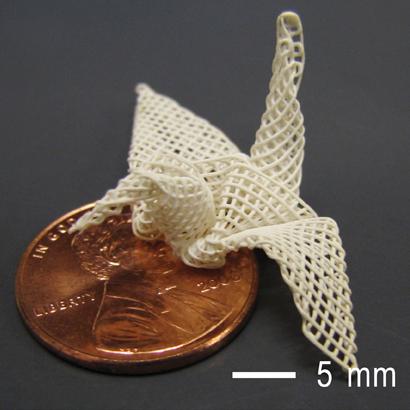Although it looks small and unassuming, the tiny origami (Japanese paper folding) crane resting on a sample plate in the laboratory of University of Illinois Professor Jennifer Lewis heralds an innovative method for making complex three-dimensional structures for biomedical devices, microfluidics and other microsystems.

Although it looks small and unassuming, the tiny origami (Japanese paper folding) crane resting on a sample plate in the laboratory of University of Illinois Professor Jennifer Lewis heralds an innovative method for making complex three-dimensional structures for biomedical devices, microfluidics and other microsystems. The bird of the titans, the size of a coin, began its journey as a printed sheet of ink composed of titanium hydride.
The research findings were published in the scientific journal Advanced Materials.
Tiny and complex structures, made of metals, ceramic materials or polymers, are used for a variety of applications, from biomedical devices to prototyping electronic components. One of the methods for creating such structures is called "direct-write assembly" in which a large printer injects ink containing metallic, polymeric or ceramic particles to create a structure, layer upon layer. In the next step, the structure is annealed at a high temperature in order to evaporate the liquid in it and connect the particles among themselves to obtain solid objects.
However, as more and more layers are added, the lower layers tend to sink or even collapse under the increasing weight - a problem that researchers encountered during their attempts to prepare titanium scaffolds for tissue engineering. One of the researchers tried a completely different approach: print a flat layer and then roll it into a spiral structure, or even into a chapel into a variety of shapes. Folding the printed sheets is not a simple task, as it seems at first glance.
"Most of our ink materials are based on aqueous compositions, so that they dry quickly. They become very stiff and may crack when folded," said the lead researcher, who is a professor of materials science and engineering at the University of Illinois. The challenge in the next step was to find a solution that would make the printed layers flexible enough so that they could be folded, and still stable enough to retain their structure after folding and annealing.
The research team solved the problem by imitating origami created by wet folding, a method in which paper is partially moistened to increase its flexibility. Through the use of a mixture of solvents, one that dries quickly and the other that dries slowly, the sheets dry partially and still remain flexible enough to allow them to be folded in several steps - 15 steps in the case of the crane.
Says co-researcher, Professor David Dunand: "I already knew how to turn titanium hydride into metallic titanium without contaminating the ink, based on previous research conducted in my laboratory." The researcher focused on a way to forge the soft origami structures of titanium hydride into rigid objects composed of metallic titanium.
The combination of printing methods with wet origami methods enables the preparation of more complex structures - such as protruding crane wings, a feature that cannot be produced by direct printing alone. In addition, the research team was able to prepare sheets with a variety of patterns, thus adding another level to the complexity of the construction.
"By combining these methods, it is possible to quickly prepare very complex structures that are simply not possible to prepare with other existing production methods," adds the lead researcher.
Next, the team hopes to expand the origami collection to include much larger and smaller structures, with a variety of ink types. For example, the method can be extended to a variety of metals and other ceramic materials ranging from alloys of steel, nickel and cobalt to other noble and stubborn metals.
The researchers also plan to investigate possible applications of lightweight structures, biomedical devices, sensors and more.
"We have really only begun to take advantage of the power of this method," adds the researcher.

2 תגובות
Remy try again, something is 50 years:
http://www.tapuz.co.il/blog/ViewEntry.asp?EntryId=1065939
Very nice. In the Star Trek TV series, food is prepared using such a device. Who knows, maybe in 250 years it won't be MDB.